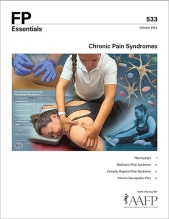
Chronic pain. We all know friends or relatives who have it. We all know patients who have it. The question is, how can we make it so they had it instead of have it?
In this edition of FP Essentials, Drs. Flynn, Henson, Grinshpun, and Raymond provide us with guidance on how to diagnose and manage, and in some cases prevent, several of the most common chronic pain syndromes.
We learn about fibromyalgia in Section One and myofascial pain syndrome in Section Two. Both are conditions for which there are no definitive diagnostic tests. The authors discuss the clinical findings needed to make these diagnoses, along with the many treatment options available. At present, no one option has been shown to be more effective than the others. Management should be tailored to each patient’s situation.
Section Three covers complex regional pain syndrome (CRPS), which typically occurs after an extremity injury. We learn not only that the most important treatment options are nonpharmacologic, but also that initiating treatment quickly is essential because as time passes, CRPS is more likely to become an irreversible chronic condition. There is growing evidence that vitamin C can reduce the risk of developing CRPS after an extremity injury.
Finally, Section Four reviews chronic neuropathic pain, something we all see in practice because it occurs in many patients with diabetes. There are effective treatments, some of which are approved by the Food and Drug Administration (FDA) specifically for neuropathic pain.
When reading this edition, you may feel overwhelmed by all the treatment options, but if you can tailor them to your patient’s specific needs, they can make a big difference.
Barry D. Weiss, MD, FAAFP, Medical Editor
Professor, Department Family and Community Medicine
University of Arizona College of Medicine, Tucson
